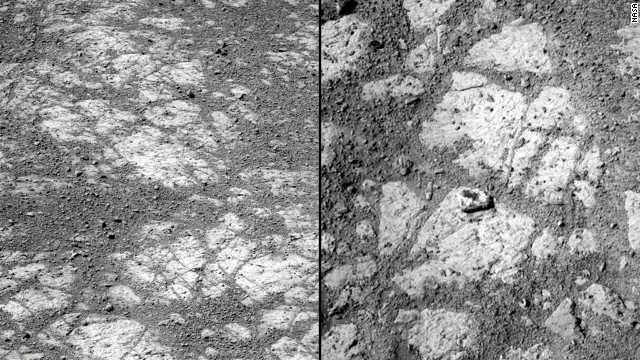 Scientists are baffled by the sudden appearance of a jelly doughnut-like rock that the Opportunity rover spotted in January 2014. These are images of the same location; the rock on the right was not there 12 days earlier. Researchers now believe the rover's wheels flicked the rock into its current spot.
Scientists are baffled by the sudden appearance of a jelly doughnut-like rock that the Opportunity rover spotted in January 2014. These are images of the same location; the rock on the right was not there 12 days earlier. Researchers now believe the rover's wheels flicked the rock into its current spot.  NASA's twin rovers, Spirit and Opportunity, have revealed many secrets of the Red Planet since landing on Mars in January 2004. Spirit stopped communicating in 2010, but Opportunity is still collecting data. This illustration depicts the identical look of both rovers.
NASA's twin rovers, Spirit and Opportunity, have revealed many secrets of the Red Planet since landing on Mars in January 2004. Spirit stopped communicating in 2010, but Opportunity is still collecting data. This illustration depicts the identical look of both rovers.  This first color photo using Spirit's panoramic camera was the highest-resolution image ever taken on another planet's surface at the time.
This first color photo using Spirit's panoramic camera was the highest-resolution image ever taken on another planet's surface at the time. 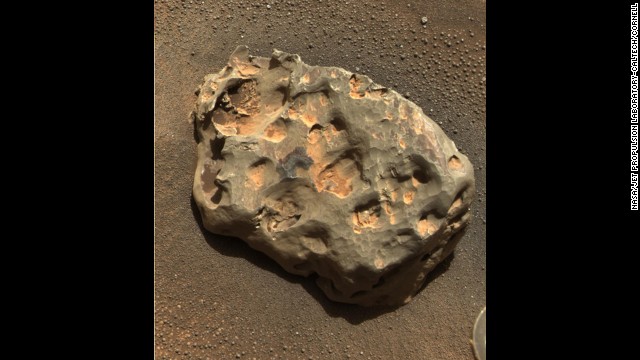 Opportunity discovered the first meteorite identified on a planet other than Earth. The rover's panoramic camera photographed the basketball-size object mostly composed of iron and nickel on January 6, 2005.
Opportunity discovered the first meteorite identified on a planet other than Earth. The rover's panoramic camera photographed the basketball-size object mostly composed of iron and nickel on January 6, 2005. 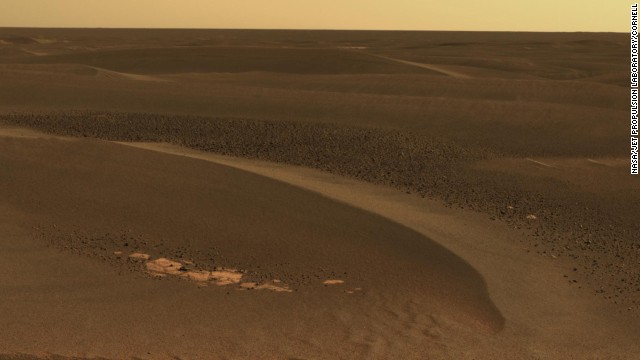 The Opportunity rover has studied windblown ripples in an area called the Meridiani Planum. This image, taken on April 27, 2006, shows a field of rocks known as cobbles among ripples about 8 inches high. The windblown ripples are likely left from a time when wind patterns were different, said planetary scientist Ray Arvidson.
The Opportunity rover has studied windblown ripples in an area called the Meridiani Planum. This image, taken on April 27, 2006, shows a field of rocks known as cobbles among ripples about 8 inches high. The windblown ripples are likely left from a time when wind patterns were different, said planetary scientist Ray Arvidson. 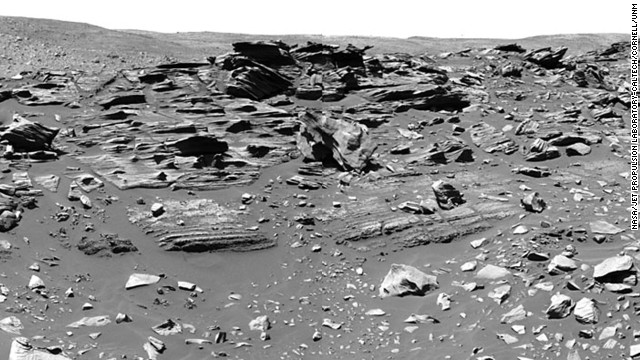 In February 2006, Spirit arrived at a geological feature called Home Plate, about 260 feet in diameter. It was so named because it looks like a baseball diamond's home plate from orbit. In this area, the rover found a material called opaline silica, a discovery important for understanding conditions that would have supported life on Mars. Scientists believe this material formed when water interacted with volcanic material known as with magma.
In February 2006, Spirit arrived at a geological feature called Home Plate, about 260 feet in diameter. It was so named because it looks like a baseball diamond's home plate from orbit. In this area, the rover found a material called opaline silica, a discovery important for understanding conditions that would have supported life on Mars. Scientists believe this material formed when water interacted with volcanic material known as with magma. 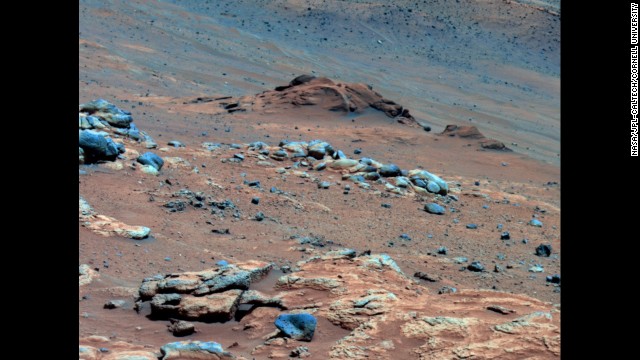 Spirit made another discovery linked to the possibility that Mars could have supported life. This photo is from that location -- an outcrop called Comanche -- in 2005. In 2010, scientists combined data from the rover's three spectrometers and suggested the composition of Comanche is about one-fourth magnesium iron carbonate. This finding indicates the environment was once wet and nonacidic and could have been favorable to life.
Spirit made another discovery linked to the possibility that Mars could have supported life. This photo is from that location -- an outcrop called Comanche -- in 2005. In 2010, scientists combined data from the rover's three spectrometers and suggested the composition of Comanche is about one-fourth magnesium iron carbonate. This finding indicates the environment was once wet and nonacidic and could have been favorable to life. 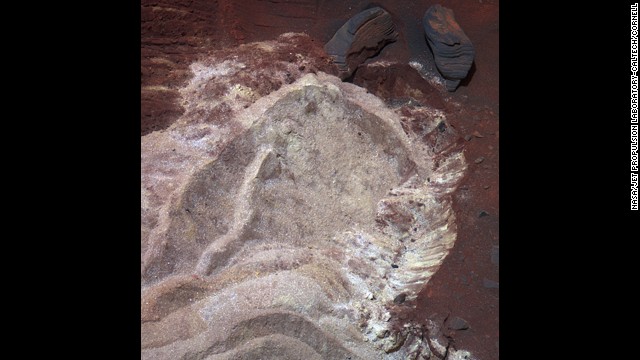 Soft soil was exposed when Spirit's wheels dug into a patch of ground dubbed Troy in 2009. While stationed there, the rover was able to show scientists that water, possibly in the form of snowmelt, had trickled into the subsurface relatively recently. Layers of soil with different compositions suggest that thin films of water may have gotten into the ground from frost or snow. Scientists believe Mars could have had cyclical climate changes when the planet was tilted farther on its axis.
Soft soil was exposed when Spirit's wheels dug into a patch of ground dubbed Troy in 2009. While stationed there, the rover was able to show scientists that water, possibly in the form of snowmelt, had trickled into the subsurface relatively recently. Layers of soil with different compositions suggest that thin films of water may have gotten into the ground from frost or snow. Scientists believe Mars could have had cyclical climate changes when the planet was tilted farther on its axis.  Both Spirit and Opportunity examined the frequency and dynamics of dust devils, which help scientists understand how wind moves dust and sand in a thin atmosphere. Spirit saw dozens of dust devils, but Opportunity, located halfway around the planet, likely never encountered one until more than six years into its mission. An image from July 15, 2010, shows a column of swirling dust.
Both Spirit and Opportunity examined the frequency and dynamics of dust devils, which help scientists understand how wind moves dust and sand in a thin atmosphere. Spirit saw dozens of dust devils, but Opportunity, located halfway around the planet, likely never encountered one until more than six years into its mission. An image from July 15, 2010, shows a column of swirling dust. 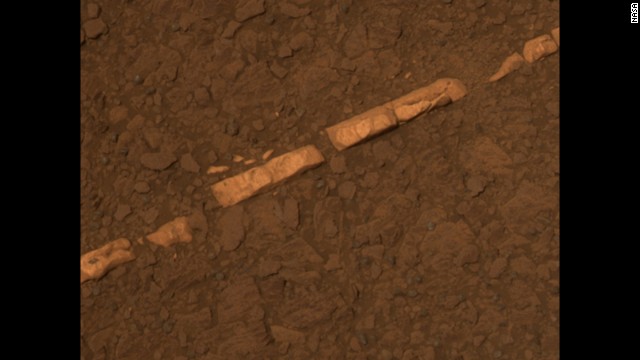 Opportunity found bright veins of a mineral that appeared to be gypsum. The vein shown here is informally called Homestake. The mineral is deposited by water. It and other deposits that look similar are in an area where sulfate-rich and volcanic bedrock meet -- at the rim of Endeavour Crater, where Opportunity is currently located.
Opportunity found bright veins of a mineral that appeared to be gypsum. The vein shown here is informally called Homestake. The mineral is deposited by water. It and other deposits that look similar are in an area where sulfate-rich and volcanic bedrock meet -- at the rim of Endeavour Crater, where Opportunity is currently located. 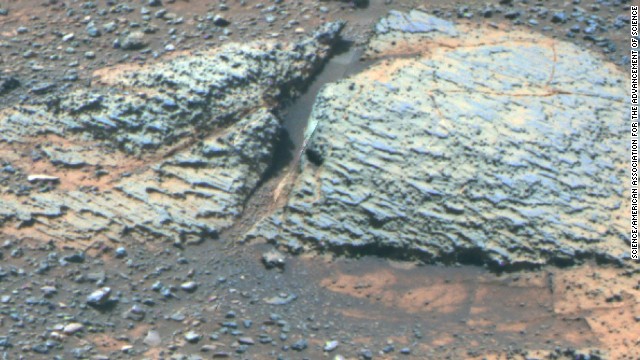 A 2014 study with data from Opportunity suggests that water in the Endeavour Crater region would have been more favorable to microbial life before rather than after the crater formed. This rock is from an area known as Whitewater Lake, part of the crater's rim.
A 2014 study with data from Opportunity suggests that water in the Endeavour Crater region would have been more favorable to microbial life before rather than after the crater formed. This rock is from an area known as Whitewater Lake, part of the crater's rim. 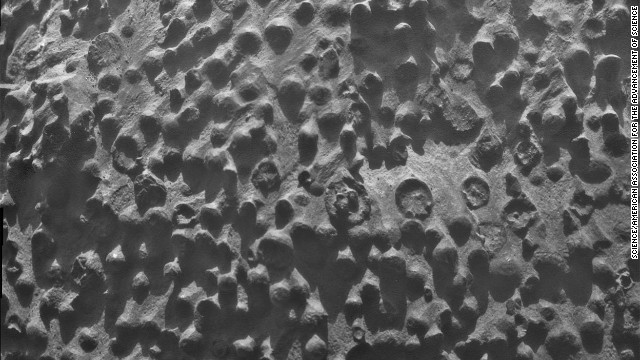 Another interesting formation that Opportunity has discovered is at an outcrop called Kirkwood. This image shows spherical objects that are as much as one-eighth of an inch in diameter.
Another interesting formation that Opportunity has discovered is at an outcrop called Kirkwood. This image shows spherical objects that are as much as one-eighth of an inch in diameter. - Researchers: Mars Opportunity rover's wheel broke off a piece of rock
- That piece is the 'mystery rock' that looks like a doughnut
- The rock has high levels of manganese and sulfur
(CNN) -- The "jelly doughnut" rock that seemed to appear out of nowhere on Mars last month did not fall out of an extraterrestrial pastry box.
The rock had been mysterious to scientists because Mars rover Opportunity photographed it in a spot where the rock had not been present just four days earlier. Steve Squyres, lead scientist of the Mars Exploration Rover mission, described it as a white rock with a dark red low spot in the middle. The rock, more than 1.5 inches wide, was named Pinnacle Island.
So where did it come from, then?
Drumroll please:
Researchers now say Pinnacle Island is a piece of a larger rock, which Opportunity broke and moved with its wheel in early January. Further images from the rover reveal the original rock that the rover's wheel must have struck.
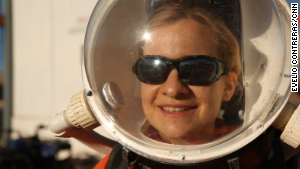 See what it's like to live on Mars
See what it's like to live on Mars  She could be on a one-way trip to Mars
She could be on a one-way trip to Mars 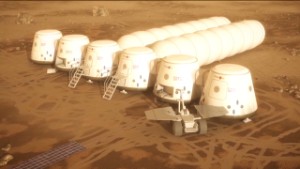 Mars One mission accepting applications
Mars One mission accepting applications "Once we moved Opportunity a short distance, after inspecting Pinnacle Island, we could see directly uphill an overturned rock that has the same unusual appearance," said Ray Arvidson of Washington University in St. Louis, deputy principal directory of Opportunity, in a statement. "We drove over it. We can see the track. That's where Pinnacle Island came from."
No, that's not as exciting as if the rock had crawled into view on its own or been dropped there by aliens. But now that this puzzle has been solved, the rover team plans to drive Opportunity south and uphill to look at exposed rock layers on a slope.
The rock has high levels of manganese and sulfur, which may have been concentrated in the rock because of water, researchers say.
"This may have happened just beneath the surface relatively recently," Arvidson said, "or it may have happened deeper below ground longer ago and then, by serendipity, erosion stripped away material above it and made it accessible to our wheels."
Opportunity weighs 384 pounds and measures about 5 feet in both length and height. It recently celebrated 10 years since its January 25, 2004, landing. Opportunity's twin, Spirit, landed on January 4, 2004.
Spirit stopped communicating in 2010, but Opportunity continues to reveal details about the Red Planet's former habitable conditions.
NASA: 2 places on Mars could have been habitable
Opportunity is the older, less technologically advanced of the two NASA rovers currently exploring Mars.
The car-sized Curiosity rover, representing a $2.5 billion mission, is now on its way to Mount Sharp, a sedimentary formation that will allow the rover to explore Mars' history by driving up the peak's slope and exploring rock chemical composition layer by layer.
NASA is planning to launch another Curiosity-sized rover in 2020, which could collect samples that later missions might return to Earth.

 See what it's like to live on Mars
See what it's like to live on Mars  She could be on a one-way trip to Mars
She could be on a one-way trip to Mars  Mars One mission accepting applications
Mars One mission accepting applications  Scientists are baffled by the sudden appearance of a jelly doughnut-like rock that the Opportunity rover spotted in January 2014. These are images of the same location; the rock on the right was not there 12 days earlier. Researchers now believe the rover's wheels flicked the rock into its current spot.
Scientists are baffled by the sudden appearance of a jelly doughnut-like rock that the Opportunity rover spotted in January 2014. These are images of the same location; the rock on the right was not there 12 days earlier. Researchers now believe the rover's wheels flicked the rock into its current spot.  NASA's twin rovers, Spirit and Opportunity, have revealed many secrets of the Red Planet since landing on Mars in January 2004. Spirit stopped communicating in 2010, but Opportunity is still collecting data. This illustration depicts the identical look of both rovers.
NASA's twin rovers, Spirit and Opportunity, have revealed many secrets of the Red Planet since landing on Mars in January 2004. Spirit stopped communicating in 2010, but Opportunity is still collecting data. This illustration depicts the identical look of both rovers.  This first color photo using Spirit's panoramic camera was the highest-resolution image ever taken on another planet's surface at the time.
This first color photo using Spirit's panoramic camera was the highest-resolution image ever taken on another planet's surface at the time.  Opportunity discovered the first meteorite identified on a planet other than Earth. The rover's panoramic camera photographed the basketball-size object mostly composed of iron and nickel on January 6, 2005.
Opportunity discovered the first meteorite identified on a planet other than Earth. The rover's panoramic camera photographed the basketball-size object mostly composed of iron and nickel on January 6, 2005.  The Opportunity rover has studied windblown ripples in an area called the Meridiani Planum. This image, taken on April 27, 2006, shows a field of rocks known as cobbles among ripples about 8 inches high. The windblown ripples are likely left from a time when wind patterns were different, said planetary scientist Ray Arvidson.
The Opportunity rover has studied windblown ripples in an area called the Meridiani Planum. This image, taken on April 27, 2006, shows a field of rocks known as cobbles among ripples about 8 inches high. The windblown ripples are likely left from a time when wind patterns were different, said planetary scientist Ray Arvidson.  In February 2006, Spirit arrived at a geological feature called Home Plate, about 260 feet in diameter. It was so named because it looks like a baseball diamond's home plate from orbit. In this area, the rover found a material called opaline silica, a discovery important for understanding conditions that would have supported life on Mars. Scientists believe this material formed when water interacted with volcanic material known as with magma.
In February 2006, Spirit arrived at a geological feature called Home Plate, about 260 feet in diameter. It was so named because it looks like a baseball diamond's home plate from orbit. In this area, the rover found a material called opaline silica, a discovery important for understanding conditions that would have supported life on Mars. Scientists believe this material formed when water interacted with volcanic material known as with magma.  Spirit made another discovery linked to the possibility that Mars could have supported life. This photo is from that location -- an outcrop called Comanche -- in 2005. In 2010, scientists combined data from the rover's three spectrometers and suggested the composition of Comanche is about one-fourth magnesium iron carbonate. This finding indicates the environment was once wet and nonacidic and could have been favorable to life.
Spirit made another discovery linked to the possibility that Mars could have supported life. This photo is from that location -- an outcrop called Comanche -- in 2005. In 2010, scientists combined data from the rover's three spectrometers and suggested the composition of Comanche is about one-fourth magnesium iron carbonate. This finding indicates the environment was once wet and nonacidic and could have been favorable to life.  Soft soil was exposed when Spirit's wheels dug into a patch of ground dubbed Troy in 2009. While stationed there, the rover was able to show scientists that water, possibly in the form of snowmelt, had trickled into the subsurface relatively recently. Layers of soil with different compositions suggest that thin films of water may have gotten into the ground from frost or snow. Scientists believe Mars could have had cyclical climate changes when the planet was tilted farther on its axis.
Soft soil was exposed when Spirit's wheels dug into a patch of ground dubbed Troy in 2009. While stationed there, the rover was able to show scientists that water, possibly in the form of snowmelt, had trickled into the subsurface relatively recently. Layers of soil with different compositions suggest that thin films of water may have gotten into the ground from frost or snow. Scientists believe Mars could have had cyclical climate changes when the planet was tilted farther on its axis.  Both Spirit and Opportunity examined the frequency and dynamics of dust devils, which help scientists understand how wind moves dust and sand in a thin atmosphere. Spirit saw dozens of dust devils, but Opportunity, located halfway around the planet, likely never encountered one until more than six years into its mission. An image from July 15, 2010, shows a column of swirling dust.
Both Spirit and Opportunity examined the frequency and dynamics of dust devils, which help scientists understand how wind moves dust and sand in a thin atmosphere. Spirit saw dozens of dust devils, but Opportunity, located halfway around the planet, likely never encountered one until more than six years into its mission. An image from July 15, 2010, shows a column of swirling dust.  Opportunity found bright veins of a mineral that appeared to be gypsum. The vein shown here is informally called Homestake. The mineral is deposited by water. It and other deposits that look similar are in an area where sulfate-rich and volcanic bedrock meet -- at the rim of Endeavour Crater, where Opportunity is currently located.
Opportunity found bright veins of a mineral that appeared to be gypsum. The vein shown here is informally called Homestake. The mineral is deposited by water. It and other deposits that look similar are in an area where sulfate-rich and volcanic bedrock meet -- at the rim of Endeavour Crater, where Opportunity is currently located.  A 2014 study with data from Opportunity suggests that water in the Endeavour Crater region would have been more favorable to microbial life before rather than after the crater formed. This rock is from an area known as Whitewater Lake, part of the crater's rim.
A 2014 study with data from Opportunity suggests that water in the Endeavour Crater region would have been more favorable to microbial life before rather than after the crater formed. This rock is from an area known as Whitewater Lake, part of the crater's rim.  Another interesting formation that Opportunity has discovered is at an outcrop called Kirkwood. This image shows spherical objects that are as much as one-eighth of an inch in diameter.
Another interesting formation that Opportunity has discovered is at an outcrop called Kirkwood. This image shows spherical objects that are as much as one-eighth of an inch in diameter. 











No comments:
Post a Comment